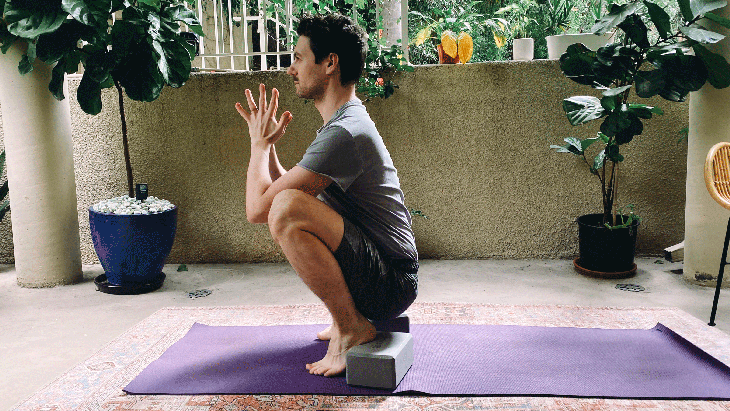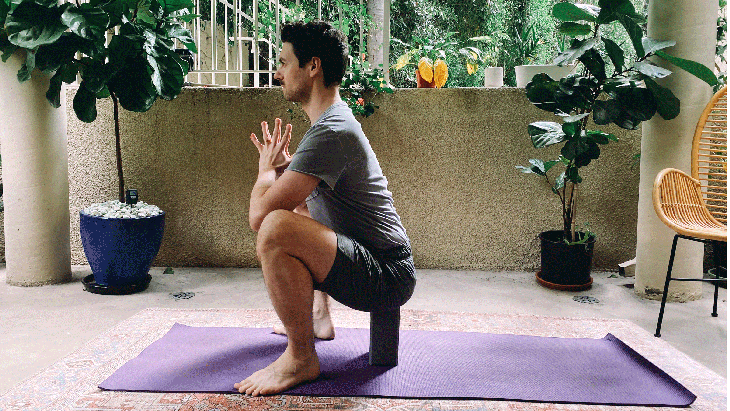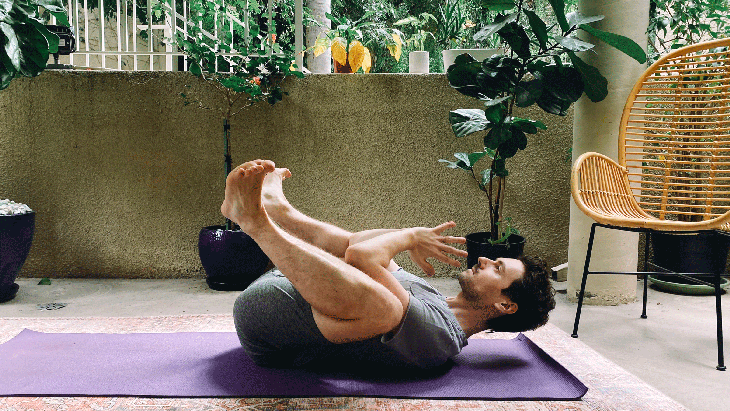Heading out the door? Read this article on the new Outside+ app available now on iOS devices for members! Download the app.
A few years ago, I was observing my nephew and nieces playing, and each of them was sitting on the floor in various ways, including the classic Vajrasana (Thunderbolt Pose), a version of Hero Pose with the feet turned out, Sukhasana (Easy Pose), and Malasana (Garland or Squat Pose). I was reminded that there are many sitting positions that we instinctively fall into as children but then abandon as we become older.
At the time, the experience inspired me to vary the way that I sit on the floor. Years later, Malasana remains my go-to option.
In the full, deep squatting position of a yoga squat, the feet are usually just slightly wider than hip-distance apart and turned slightly out. The pose involves extreme knee flexion in which the back of the thighs rest against the calves while the heels rest flat on the floor. The hands are typically positioned in prayer with the elbows pressing into the inner legs and the legs pressing back into the elbows.
Malasana stretches the calf muscles, groins, lower back, and glutes and can help improve ankle, knee, and hip mobility. In a recent study, the authors referred to squatting as an “active rest” posture that requires higher levels of lower limb muscle activity than chair sitting and suggested that spending more time squatting may help reduce the negative health impacts of inactivity in industrialized populations.
However, squatting deeply can be challenging for anyone, particularly those of us who are working with a knee, ankle, or hip injury or have reduced mobility in these areas. As with any pose, there are many ways to approach Malasana so that you can find a variation that works for your unique needs.
4 ways to practice Malasana
Preparation
Practicing Baddha Konasana (Bound Angle Pose), Upavistha Konasana (Wide-Angled Seated Forward Bend), and Goddess Pose can help prepare your legs for Malasana.

1. Malasana with support beneath your heels
This variation can work well for anyone who experiences limited mobility in their ankles.
Begin in Tadasana (Mountain Pose) with your feet slightly wider than hip distance apart and turned out slightly. Place blocks or a rolled blanket underneath your heels. Slowly bend your knees until the back of your thighs rest against your calves. Aim to keep your heels pressing down into the folded blanket. You have the option to replace the blanket with a yoga block if you wish to raise your heels further.
Place your palms together to encourage your chest to broaden and press your elbows into your inner legs as your legs press back into your elbows.

2. Malasana with a block beneath your seat
This variation can work well for anyone who experiences limited mobility in their ankles, knees and hips.
Begin in Tadasana (Mountain Pose) with your feet slightly wider than hip distance apart and turned out slightly. Place a stack of two or three yoga blocks between your feet and just behind your heels. Slowly bend your knees until you are sitting on the blocks. You have the option to remove or add yoga blocks if you wish to lower or raise your seat. Place your palms together to encourage your chest to broaden and press your elbows into your inner legs as your legs press back into your elbows.

3. Malasana in a chair
This variation creates a similar shape as Malasana, but from a seated position. It’s ideal for anyone who has issues rising from a seated position or has limited mobility in their ankles, knees and hips.
Sit towards the front of your chair with your feet slightly wider than hip distance apart and turned out slightly. You can position your ankles either under your knees or slightly behind your knees. Fold forward at your hips, placing your hands in Prayer and pressing your elbows into your inner legs as your legs press back into your elbows. To deepen the position, you can fold further forward and step your feet further back behind your knees.

4. Malasana on your back
This variation can work well for anyone who wants to experience the pose from a different perspective or doesn’t want to apply load to their ankles, knees, and hips in this position.
Lie on your back and bend your knees with your feet slightly wider than hip distance apart. Slowly draw your thighs back toward the sides of your waist. Lift your upper torso slightly as you place your hands in Prayer and press your elbows into your inner legs as your legs press back into your elbows.
See also: Different ways to practice other common yoga poses, including Downward-Facing Dog, Tree Pose, and Child’s Pose.
About our contributor
Andrew McGonigle has studied anatomy for more than 20 years. After initially studying to become a doctor, he moved away from Western medicine to become a yoga and anatomy teacher. He shares his knowledge of the body and the ways it moves in yoga teacher training courses throughout the world and leads his own Yoga Anatomy Online Course. His second book, The Physiology of Yoga, was published in June 2022. To learn more about Andrew, check out doctor-yogi.com or follow him on Instagram @doctoryogi.
